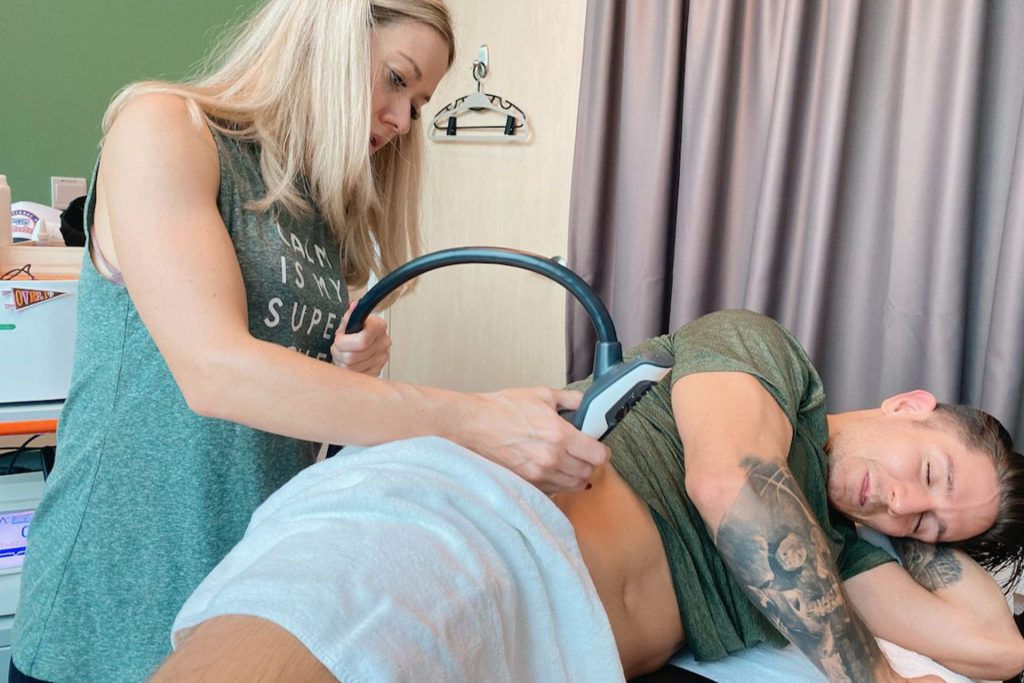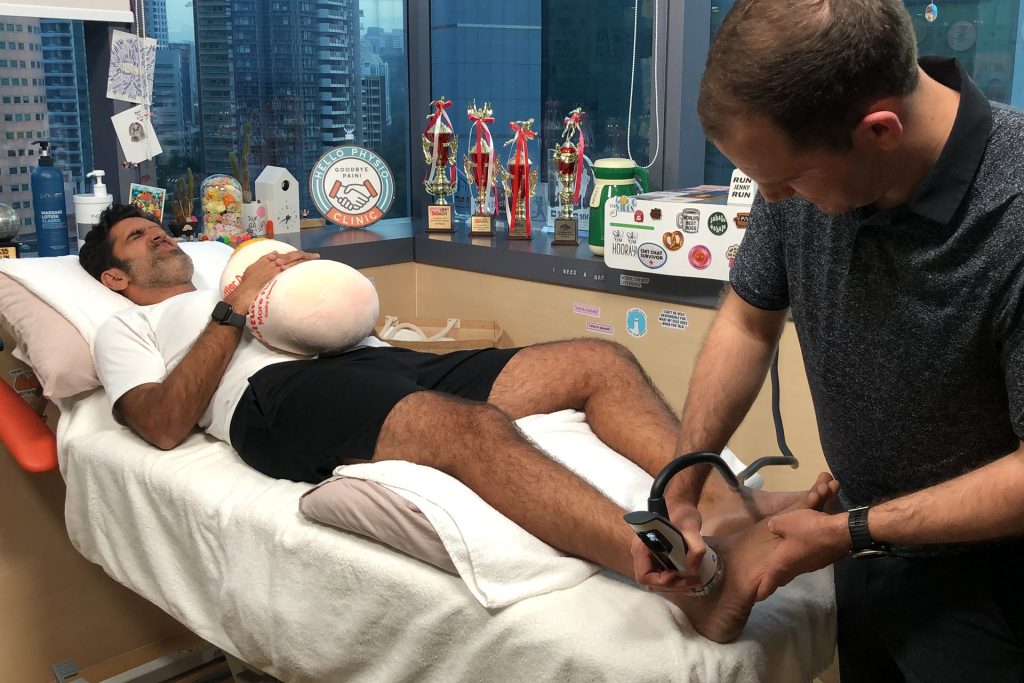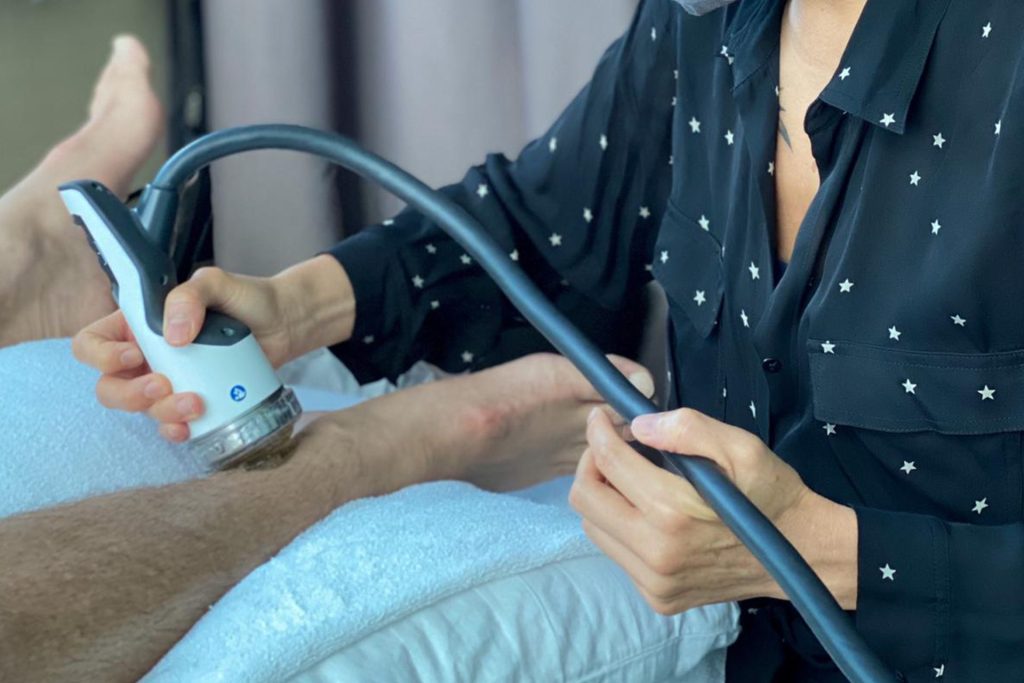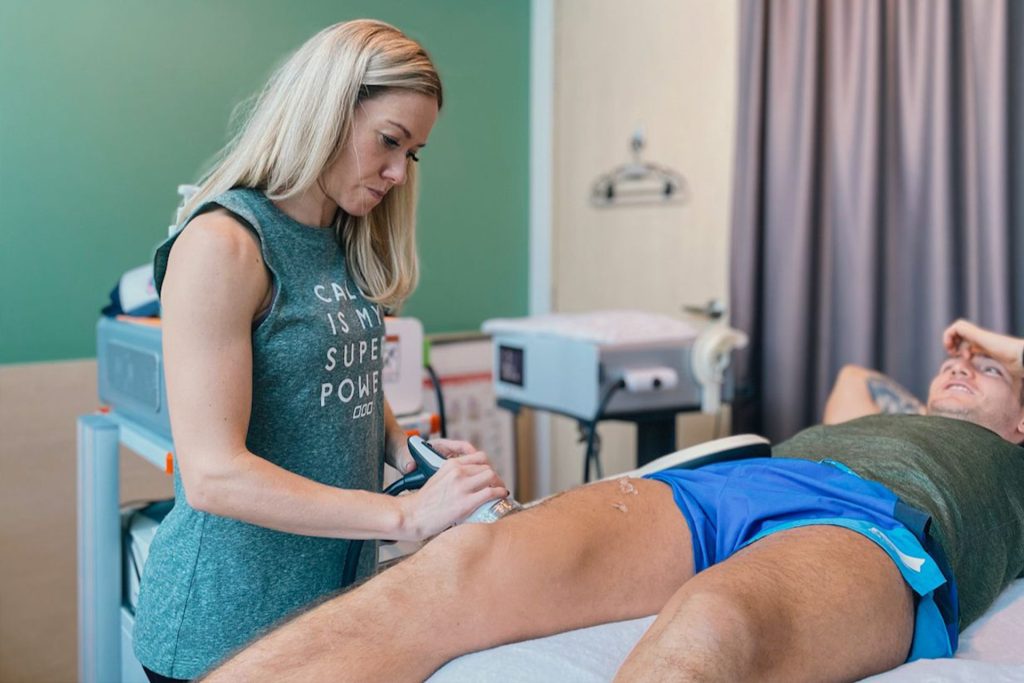What Is Shockwave Therapy in Singapore
Extracorporeal Shockwave Therapy (ESWT) is a non-invasive treatment that uses intense energy waves, or “shockwaves,” to reduce pain and promote healing in chronic orthopedic conditions. By targeting injured soft tissue, ESWT helps alleviate discomfort and accelerates the body’s natural repair process.
ESWT delivers low-energy sound or acoustic waves to stimulate a skeletal muscle response. This triggers reactions within the cell’s core and structures, enhancing tissue healing. The shockwaves generate positive pressure in tissues, leading to energy absorption, reflection, and transmission. These effects can address calcified tissues, improve healing, and change how pain is perceived.
Shockwaves also activate chemical signals that stimulate the body’s inflammatory healing response, aiding cell regeneration and recovery.

HelloPhysio’s Advanced Shockwave Therapy
HelloPhysio provides both Focal and Radial Shockwave Therapy using top-tier equipment from STORZ Medical, ensuring the most effective treatment for musculoskeletal and soft tissue injuries.
- Focal Shockwaves: Penetrate deeply to treat conditions near the bone or calcified areas without damaging surrounding tissue.
- Radial Shockwaves: Cover a broader area, targeting muscle chains, trigger points, and myofascial adhesions. They are ideal for conditions such as plantar fasciitis, tennis elbow, and Achilles tendonitis.
Extracorporeal Shockwave Therapy was introduced in Singapore nearly a decade ago but has been FDA-approved internationally for treating plantar fasciitis (since 2000) and tennis elbow (since 2002).
HelloPhysio tailors shockwave treatments to your specific injury or dysfunction, offering focal and radial technologies for precise, effective care. Whether treating deep tissue calcifications or broader muscle issues, our advanced equipment and expertise provide a vital solution for lasting pain relief and healing.

What to Expect During a Shockwave Therapy Session
During a Shockwave Therapy session, your physiotherapist will use a handheld device connected to a machine that generates sound waves from compressed air. Before starting, they’ll apply ultrasound gel to the skin, which helps the shockwaves penetrate effectively. The device is then moved over the injured area with light pressure, targeting the affected tissues.
The sound waves increase blood flow to the area, which can cause mild localized irritation. This irritation stimulates positive cell repair and regeneration, prompting the body to heal. As a result, damaged or wounded tissues recover, reducing pain and discomfort.
Breaking Down Scar Tissue and Improving Mobility
ESWT treatment is particularly effective for addressing scar tissue, which often lacks elasticity and can restrict mobility in surrounding tissues. The treatment breaks down calcifications and scar tissue by delivering sound waves beneath the skin, improving joint movement and reducing pain. This enhanced range of motion can significantly improve the quality of life for patients dealing with chronic conditions.
Who Can Benefit from ESWT?
Shockwave is an excellent rehabilitation option for patients whose injuries haven’t responded to initial treatments like rest, ice, or braces. It’s also a viable alternative for those seeking to avoid invasive procedures.
What to Expect During Your Session
A typical Shockwave Therapy session lasts 15 to 20 minutes. Some patients may experience mild discomfort during the treatment, but the physiotherapist will adjust the intensity to ensure it remains manageable. Wearing loose clothing can enhance comfort during the session.
The number of sessions required depends on the treated condition and the patient’s needs. Your physiotherapist will create an individualized plan to ensure optimal recovery and results.
Shockwave treatment is a safe, effective, and non-invasive option for managing pain, improving mobility, and accelerating healing, making it a popular choice for patients with persistent injuries.

How Shockwave Therapy Works to Heal Musculoskeletal Dysfunctions
Shockwave Therapy is a versatile treatment that can be tailored to address various musculoskeletal injuries. By modulating factors such as energy flux density, number of impulses, treatment focus (focused and radial shockwave), session frequency, and post-treatment protocols, the therapy is highly adaptable to each patient’s specific needs.
Cellular Effects of Shockwave Therapy
One primary mechanism through which Shockwave Therapy promotes healing is stimulating the release of adenosine triphosphate (ATP), an energy-carrying molecule essential for cellular processes. This activation initiates cell signalling pathways and modifies ion channel function in the cell membrane, facilitating cellular repair and recovery.
Additionally, ESWT treatment induces the release of nitric oxide, a molecule with analgesic, angiogenic, and anti-inflammatory properties. These effects reduce pain, enhance blood vessel formation, and control inflammation in injured tissues.
Collagen Synthesis and Tissue Repair
Shockwave Therapy accelerates collagen synthesis, critical for repairing tendons, ligaments, and other musculoskeletal structures. While collagen is naturally produced in the body, shock waves enhance its formation, improving the density and strength of newly repaired fibers. This expedited process promotes quicker and more robust recovery.
Tendon and Bone Healing
The treatment also boosts the proliferation of tendon cells (tenocytes) and supports the differentiation of osteoprogenitor cells—stem cells that generate bone and cartilage. Enhanced tenocyte growth aids in tendon recovery, while osteoprogenitor activation promotes the formation of osteoblasts and chondrocytes, facilitating bone and cartilage repair. This cellular activity is particularly beneficial for healing stress fractures or other bone-related injuries.

Conditions Treated by Shockwave Therapy
By adjusting treatment protocols to suit specific injuries, extracorporeal shockwave therapy effectively treats a wide range of dysfunctions, including:
- Rotator Cuff Tendinopathy: Relief from shoulder pain and improved tendon healing.
- Lateral Elbow Epicondylopathy (Tennis Elbow): Reduced pain and enhanced tissue repair.
- Hip Pain: Alleviates chronic hip pain.
- Hamstring Tendinopathy: Accelerates recovery in the posterior thigh.
- Patellar Tendinopathy (Jumper’s Knee): Promotes ligament and tendon repair in the knee.
- Plantar Fasciitis: Provides relief for chronic heel pain.
- Bone Stress Injuries: Supports bone healing and reduces discomfort.
- Achilles Tendinopathy: Addresses pain and stiffness in the Achilles tendon, promoting recovery.
- Medial Tibial Stress Syndrome (Shin Splints): Reduces inflammation and pain along the shinbone.
- Calcific Shoulder Tendinopathy: Breaks down calcium deposits in the shoulder for improved mobility and reduced pain.
- Chronic Myofascial Pain: Targets trigger points and adhesions to alleviate muscle tension and improve mobility.
- Iliotibial Band Syndrome (ITBS): Reduces tension in the IT band, alleviating lateral knee and thigh pain.
- Hip Bursitis: Decreases inflammation in the hip bursa, relieves pain and improves range of motion.
- Carpal Tunnel Syndrome: Relieves nerve compression and reduces associated pain and inflammation.
- Trigger Finger: Alleviates inflammation and improves tendon flexibility in affected fingers.
Shockwave therapy’s versatility makes it a valuable treatment option for diverse musculoskeletal and soft tissue conditions. It offers targeted, noninvasive relief that promotes recovery and enhances mobility.

A Safe and Effective Modality
Shockwave Therapy’s ability to adjust treatment parameters ensures that it delivers targeted and effective care for soft tissue and musculoskeletal dysfunctions. This non-invasive therapy is a powerful option for patients seeking relief from chronic pain and injuries by boosting natural cellular processes like collagen synthesis, tendon repair, and bone regeneration.
Whether you’re recovering from tendinopathy, plantar fasciitis, or a bone stress injury, Shockwave Therapy offers a scientifically proven pathway to healing and restoration.
Contact HelloPhysio today with questions about how shockwave treatment can benefit your rehabilitation. The session cost of shockwave therapy in Singapore varies based on the injury presentation and prescriptive treatment. Make an appointment today.
Book an Appointment
Shockwave Therapy FAQs
A shockwave is an energy that can generate a peak pressure 1000 times greater than ultrasound. The first documented use of shockwave therapy was in 1980 to treat kidney stones in a lithotripsy procedure – using shockwaves to break up stones in the kidney – and ESWT is still used for this today. In 1992, it was discovered by chance that its effects on bone stimulation of the iliac crest during a lithotripsy procedure in the pelvic region. Shockwave therapy treatments were then studied in orthopedics, where shockwaves were found to improve fracture healing and could be used to treat tendon and fascia-related overuse conditions.
Focal shockwave therapy uses a smaller focal point, allowing for greater accuracy and treatment depth. It can reach up to a 12cm depth depending on the attachment used, and emits fast impulses with high energy density to allow for precise delivery to the targeted area. This treatment method creates shockwaves using a cylindrical coil that electromagnetically causes opposing magnetic fields when a beneficial current is applied.
When a pressure wave is created in the surrounding fluid medium, the shockwave has a low amount of energy dispersed, limiting any damage done to the skin and other soft tissues. Focal shockwave is best used for targeted areas at a deeper level such as tissue close to the bone, calcifications, or delayed unions and non-unions.
Radial shockwave therapy covers a larger treatment area of 3 to 4 cm depth level. This type of treatment is best for treating larger areas as it uses a slower impulse at a lower energy density. Radial shockwave technology is a pneumatic system that uses compressed air at a high speed. The shockwaves are then transmitted to the tissue where it moves radially outward into the tissue.
Shockwaves lose power the deeper they penetrate into the body. Radial Shockwave Therapy is best for superficial targeted areas such as plantar fasciitis, tennis elbow, or Achilles tendon. This treatment method is also recommended for treating muscle chains as it can break up adhesion and trigger points, allowing for myofascial release.
Radial shockwave therapy does not go as deep at the cellular level as focal shockwave therapy. The radial shockwave does cover a larger area for repair but the wave will reach the tissue level only. It is here where the tendon and bone are treated. Old wounds can be retreated by removing scars and calcification from the bone to activate the healing of the tendon to strengthen and form around the bone.
One injury that shockwave treatment is beneficial is Achilles tendinitis. Achilles tendinitis occurs when the tendon that connects the calf muscle to the heel bone gets overused, leading to discomfort, tenderness, and pain. It is a highly prevalent injury among athletes, particularly runners, as microtraumas often accumulate, resulting in injury. Shockwave therapy can treat this chronic pain, by applying pressure to the region. When used with other physiotherapy exercises, the technology can boost recovery of the tendon and help runners get back on their feet.
ESWT can also help address people suffering from tennis elbow, also known as lateral epicondylitis. Tennis elbow isn’t an injury limited to athletes as many in manual jobs can incur the same injury too. It is similar to Achilles tendinitis, where the tendon becomes overloaded by repetitive movements, leading to discomfort and pain in the arm. The pain can then spread into the wrist and forearm. There are different rehab exercises that can help with recovery. Shockwave therapy can also expedite the process and assist with pain management.

